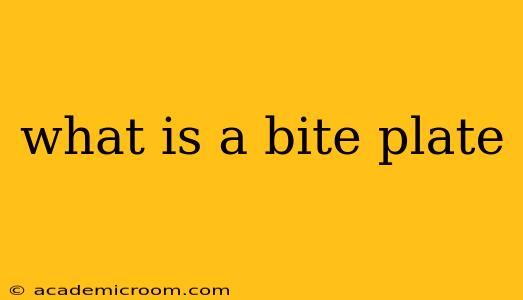A bite plate, also known as a bite splint or occlusal splint, is a custom-made oral appliance designed to reposition the jaw and alleviate various oral and facial problems. It's a relatively small, removable device usually made from acrylic resin or other similar materials, and it fits snugly over either the upper or lower teeth. While often associated with teeth grinding (bruxism), its applications are far more diverse. This comprehensive guide will delve into its uses, benefits, and potential drawbacks.
What are the Different Types of Bite Plates?
Several types of bite plates exist, each designed to address specific concerns:
-
Michigan Splint: This is perhaps the most common type. It covers the upper teeth, typically extending slightly beyond the biting surfaces to prevent teeth grinding and clenching. It's often used for treating temporomandibular joint (TMJ) disorders.
-
Maryland Splint: This type covers the lower teeth and is frequently utilized for similar purposes as the Michigan splint, particularly for managing bruxism.
-
NTI-tss Appliance: A smaller, more anterior bite plate that primarily focuses on preventing clenching of the front teeth. It's designed to be minimally invasive and often used in conjunction with other treatments.
-
Stabilization Splints: These are designed to stabilize the jaw in a specific position, often used after jaw surgery or for severe TMJ disorders.
What are Bite Plates Used For?
Bite plates serve multiple purposes, ranging from managing bruxism to addressing more complex jaw issues:
-
Treating Bruxism (Teeth Grinding): This is perhaps the most common application. By acting as a barrier between the upper and lower teeth, the bite plate protects tooth enamel from the wear and tear caused by grinding and clenching.
-
Managing Temporomandibular Joint (TMJ) Disorders: TMJ disorders encompass a range of conditions affecting the temporomandibular joint, which connects the jaw to the skull. Bite plates can help realign the jaw, reduce muscle tension, and alleviate pain associated with TMJ.
-
Alleviating Headaches and Facial Pain: Many people suffering from headaches or facial pain find relief through the use of bite plates. By improving jaw alignment and reducing muscle tension, these appliances can help minimize pain.
-
Treating Sleep Apnea (in some cases): Certain types of bite plates can help reposition the jaw and tongue, potentially improving airflow and reducing sleep apnea symptoms. However, this is not a primary treatment and should be considered in conjunction with other sleep apnea therapies.
How Do Bite Plates Work?
Bite plates work through several mechanisms:
-
Protecting Teeth: They act as a physical barrier, preventing teeth from grinding against each other during sleep or daytime clenching.
-
Repositioning the Jaw: By gently guiding the jaw into a more optimal position, bite plates can help reduce muscle strain and joint stress.
-
Reducing Muscle Tension: The improved jaw position often leads to a relaxation of the jaw muscles, reducing pain and discomfort.
Are There Any Side Effects of Using a Bite Plate?
While generally safe and effective, some people experience minor side effects, including:
-
Increased Saliva Production: This is a common initial side effect that usually subsides within a few days.
-
Slight Discomfort: Some initial discomfort or soreness is possible, particularly when first getting used to the appliance.
-
Speech Difficulties: While rare, some individuals may experience temporary difficulties with speech, particularly initially.
-
Increased Tooth Sensitivity: In some cases, increased tooth sensitivity can occur, which often resolves over time.
How Long Do I Need to Wear a Bite Plate?
The duration of bite plate use varies greatly depending on the individual's condition and treatment goals. It can range from a few weeks to several months, or even longer in some cases. Your dentist will determine the appropriate duration based on your specific needs.
What are the Costs Associated with a Bite Plate?
The cost of a bite plate can vary significantly depending on the type of appliance, the dentist's fees, and insurance coverage. It's best to discuss costs with your dentist directly to get a personalized estimate.
How Do I Clean My Bite Plate?
Proper cleaning is essential to maintain oral hygiene and prevent infection. Your dentist will provide specific instructions, but generally, rinsing with water after each use and brushing gently with a soft-bristled toothbrush is recommended.
This information is for general knowledge and does not constitute medical advice. Always consult with a qualified dental professional for diagnosis and treatment of any oral health concerns.
